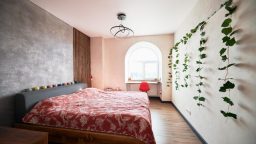Designing a small kitchen can be a tricky task. With limited space, it’s essential to make the most of every inch while ensuring the space is functional, stylish, and easy to navigate. Whether you’re working with a compact apartment kitchen or simply want to maximise your current kitchen space, clever design can transform it into a highly efficient and beautiful cooking area. Here are some top tips for designing a small kitchen that works for you.
- Prioritise Efficient Storage Solutions
In a small kitchen, storage is crucial. You need to keep your countertops clear and ensure everything has a place. One of the best ways to optimise storage is by using vertical space. Install high cabinets that go all the way up to the ceiling, allowing you to store less frequently used items out of sight.
Open shelves can also work well in smaller kitchens, giving you easy access to essentials like mugs, plates, and bowls. You can even install pull-out drawers or lazy Susans in your cabinets to make the most of every nook and cranny.
Consider using under-sink storage for cleaning supplies and add hooks or a pegboard to hang utensils, pots, or even small appliances, keeping the counters free for prep work.
- Use Light Colours to Open Up the Space
Lighter shades can make a small kitchen feel larger and more open. White, light grey, or pastel tones for walls, cabinets, and even countertops can reflect more light, brightening up the room and giving the illusion of space.
If you want a bit more personality, you can still add pops of colour through accessories, like tea towels, small appliances, or a vibrant backsplash. However, keeping the primary colours light and neutral will help maintain an airy atmosphere.
- Embrace Multi-Functional Furniture and Appliances
In a small kitchen, it’s vital to make each piece of furniture or appliance work harder for you. Consider choosing multi-functional items that serve more than one purpose. For example, a pull-out table or a folding breakfast bar can act as both a dining area and additional prep space when not in use.
You can also invest in compact, all-in-one appliances like a microwave oven or a combination fridge-freezer. These products save space while still providing the functionality you need.
- Go for Open Shelving or Glass-Front Cabinets
While closed cabinetry is the traditional choice, open shelving can be an excellent option for small kitchens. It allows you to store frequently used items in easy reach, giving the space an open, airy feel. However, open shelves do require regular cleaning and maintenance to prevent clutter from building up.
If you prefer cabinets but still want the openness, glass-front cabinets are a great alternative. They provide storage behind the glass while still allowing light to filter through, preventing the space from feeling closed off.
- Use Smart Lighting to Brighten Every Corner
Proper lighting is essential in any kitchen, but it’s even more important in a small one. A well-lit kitchen feels larger, more inviting, and more functional. Layer your lighting by incorporating task lighting (like under-cabinet lights or pendant lights above the sink or island) and ambient lighting (such as recessed ceiling lights or track lighting).
Consider using LED strips under shelves or cabinets to provide soft, even lighting that doesn’t take up any additional space. Under-cabinet lighting can also make a small kitchen feel less cluttered and create a warm, welcoming atmosphere.
- Maximise Counter Space
Counter space is at a premium in small kitchens, so keeping it clear is essential. The more open space you have for food prep, the more efficient your kitchen will be. Use compact appliances that can be easily stored when not in use, such as toasters or coffee makers.
If your kitchen lacks counter space, consider adding a fold-down countertop or an island on wheels that can be moved out of the way when not in use. A rolling cart can provide extra workspace and storage while taking up minimal space when stored against a wall.
- Install a Compact or Induction Cooktop
If you’re short on stove space, consider switching to a smaller cooktop or an induction model. Compact two-burner stoves or induction cooktops are ideal for small kitchens, as they are space-efficient and fast. An induction cooktop, in particular, offers precise temperature control and cooks food faster while being easy to clean.
Also, think about the layout of your kitchen. A simple galley layout or a L-shaped design often works best in a small space, allowing for easy movement between cooking zones without overcrowding the area.
- Create a Visual Focal Point
Even though a small kitchen doesn’t have a lot of room for dramatic decor, you can still add personality with a focal point. Consider installing a statement backsplash in an eye-catching pattern or vibrant tile. This simple addition can make the kitchen feel more polished without overwhelming the space.
Alternatively, choose bold accessories like unique lighting fixtures, colourful utensils, or decorative jars. A small, colourful rug can also add a touch of comfort and style to the floor.
- Keep the Layout Simple and Streamlined
A cluttered layout will make a small kitchen feel cramped and difficult to navigate. Stick to a straightforward kitchen layout that allows you to move around easily. The classic work triangle (the arrangement of the fridge, stove, and sink in a triangular formation) is a tried-and-true method for making the space more efficient.
Keep your kitchen layout streamlined by limiting unnecessary furniture or appliances. When each item has a purpose and is in a logical place, the space will feel more organised and functional.
- Incorporate Natural Elements
Finally, bringing a bit of nature into your kitchen can make it feel more spacious and serene. Whether it’s a small potted plant on the windowsill or fresh herbs in the corner, greenery can make the room feel fresher and more inviting. Even a wooden cutting board, bamboo utensils, or natural-fibre rugs can add warmth and texture to the space.
Conclusion
Designing a small kitchen is all about smart choices and thoughtful design. With clever storage solutions, light colours, multi-functional furniture, and efficient appliances, you can create a kitchen that feels open, organised, and beautiful. Small spaces don’t need to feel cramped—by making the most of the space you have, your kitchen can be both functional and stylish, no matter how tiny it is!





